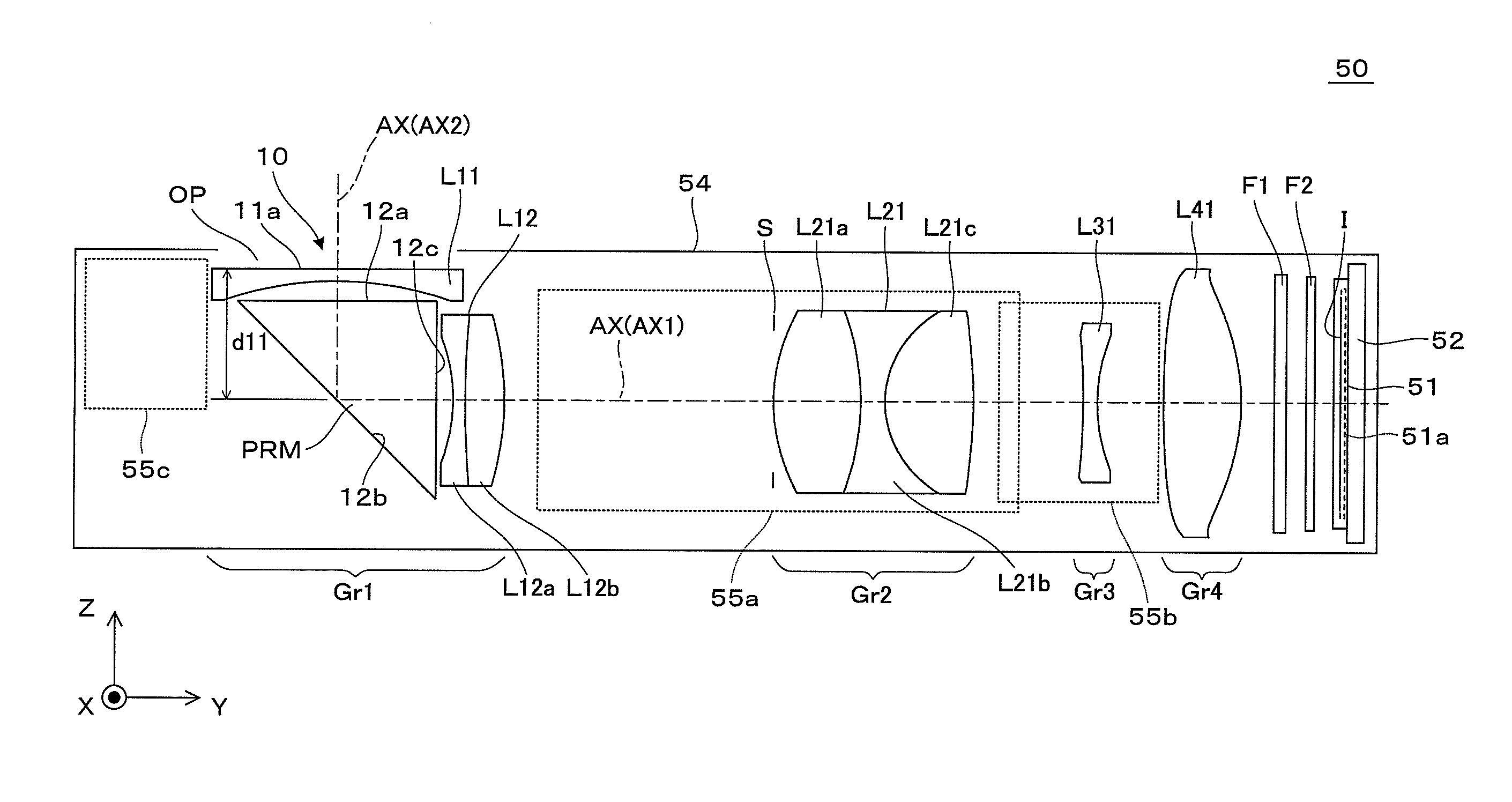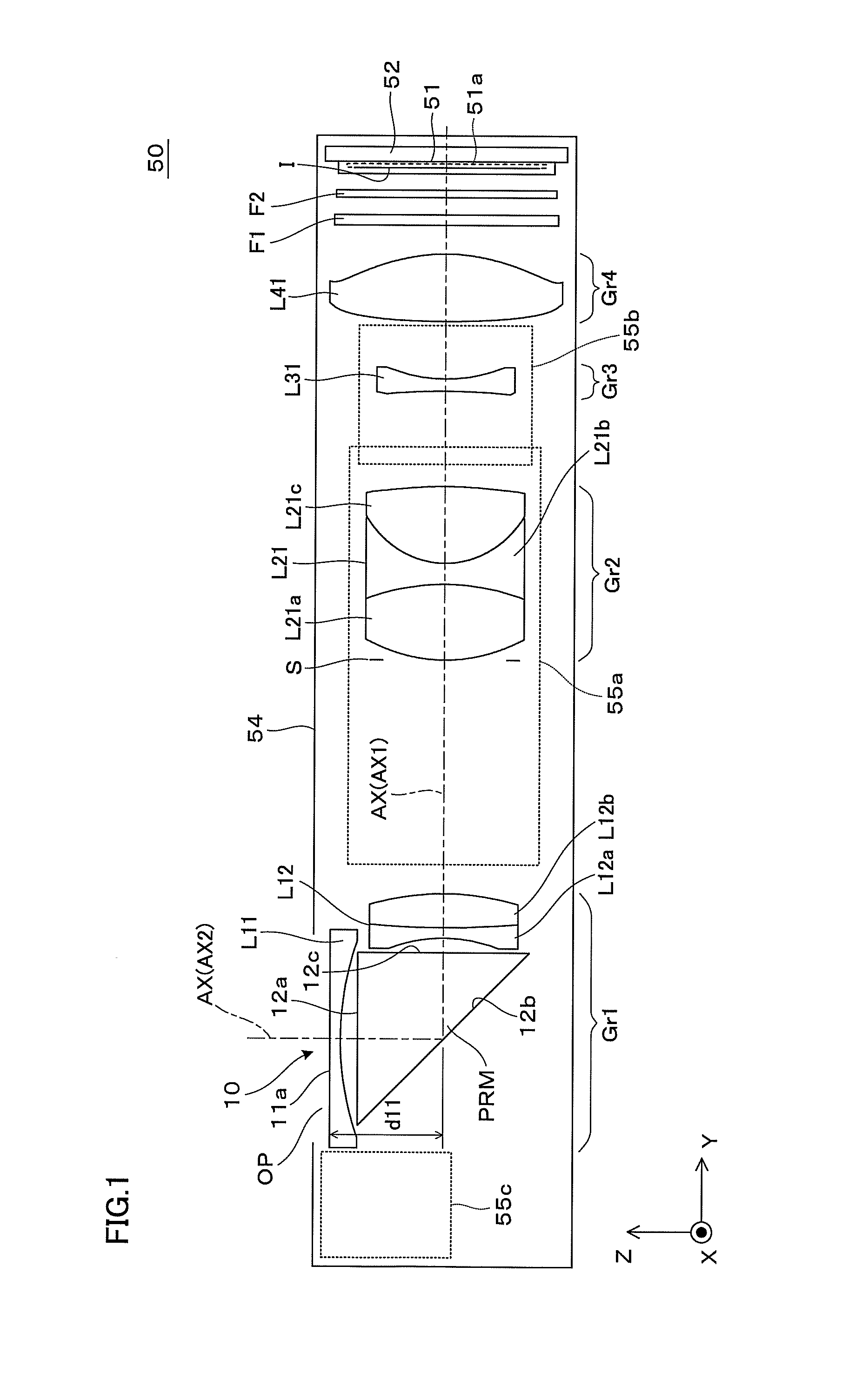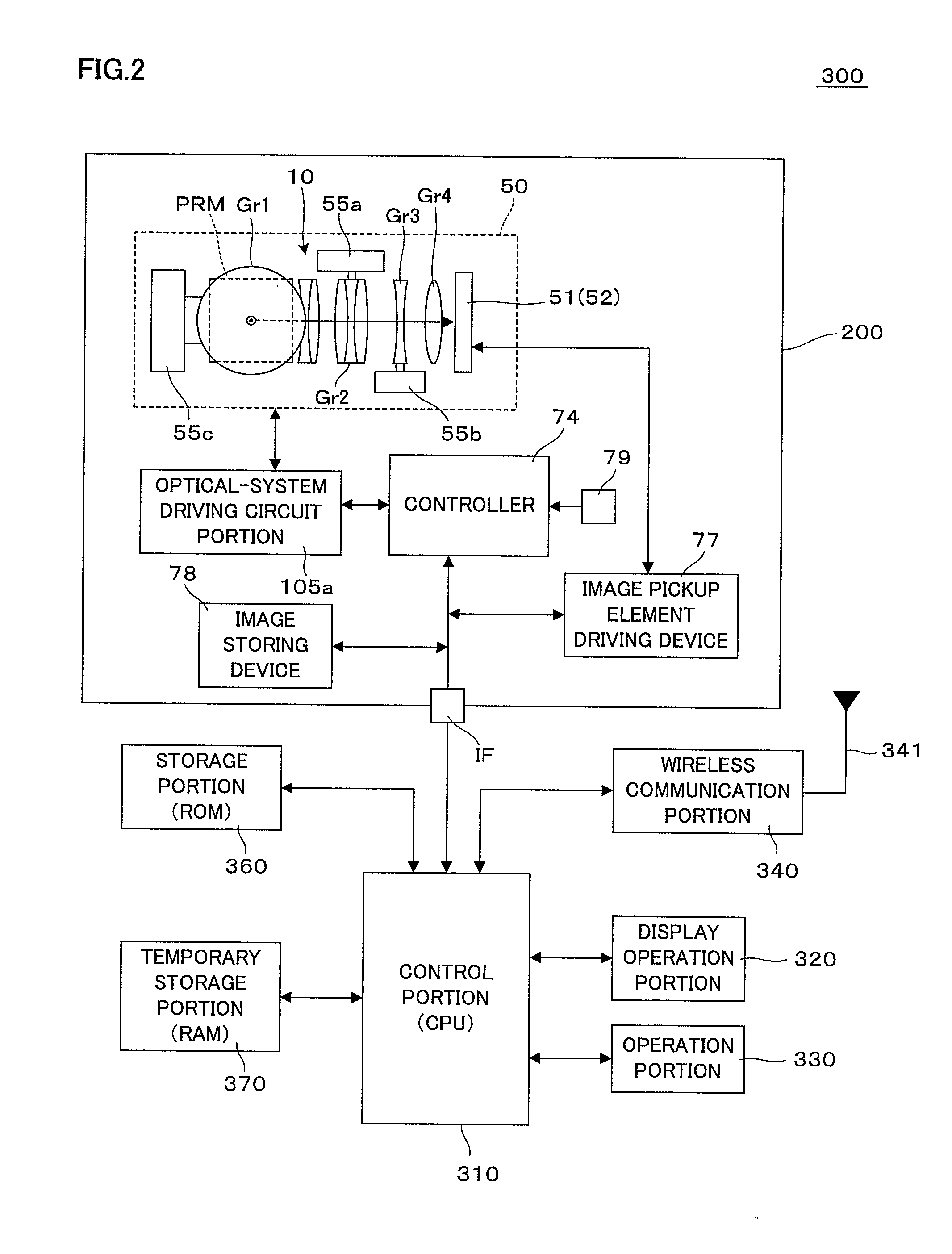Zoom Lens And Image Pickup Device
a technology of image pickup and zoom lens, which is applied in the field of zoom lens, can solve the problems of increasing the effective diameter, increasing the thickness, and using the thinning method, and achieves the effect of reducing the size and favorably suppressing the various aberrations
- Summary
- Abstract
- Description
- Claims
- Application Information
AI Technical Summary
Benefits of technology
Problems solved by technology
Method used
Image
Examples
example 1
[0125]Basic features of a zoom lens in an example 1 are as follows:
Zoom ratio: 2.85
Lens entire length: 28.099
d11: 3.250
[0126]Lens data of the example 1 is shown in Table 1. In the following (including the lens data in Tables), a power multiplier of 10 (2.5×10−02, for example) is expressed by using E (2.5E-02, for example).
TABLE 1[Radius of curvature, surface distance and the like]Surf. NR(mm)D(mm)Ndνdeffective radius (mm) 1inf.0.3002.0010029.12.79 210.4460.4952.60 3inf.4.9112.0006925.52.55 4inf.0.4141.79 5−5.3820.3001.8830040.81.75 629.2500.9651.9228620.91.84 7−9.172d11.94 8(stop)inf.0.0001.98 9*5.4562.1591.8513540.12.0910−7.8460.6001.6989530.12.02113.0252.1911.5920167.01.9112*−13.303d21.8813*−14.7280.3501.5447056.21.8614*6.588d31.8915*33.0481.9311.5447056.23.0916*−6.4080.8223.1717inf.0.3001.5168064.23.0418inf.0.5003.0319inf.0.2101.5168064.22.9820inf.0.6402.97[Aspherical Coefficient]Ninth SurfaceK = 0.00000E+00, A4 = −0.65103E−03, A6 = 0.50692E−04,A8 = −0.13360E−04, A10 = 0.89604E−0...
example 2
[0134]Basic features of a zoom lens of an example 2 are as follows:
Zoom ratio: 2.85
Lens entire length: 27.523
d11: 2. 450
[0135]Lens data of the example 2 is shown in Table 4.
TABLE 4[Radius of curvature, surface distance and the like]Surf. NR(mm)D(mm)Ndνdeffective radius (mm) 1−13.5505.3502.0006925.52.88 2inf.0.1852.08 3−15.4800.4001.8348142.72.07 46.7101.1301.9228620.91.99 5529.000d11.91 6(stop)inf.0.0001.82 7*6.1851.8501.8513540.11.88 8−5.5000.4001.6989530.11.83 93.7201.7101.6188163.91.7510*−11.813d21.7011*19.6820.3001.5447056.21.7112*3.765d31.7013*−19.9451.7301.5447056.23.0114*−4.6751.3103.1415inf.0.3001.5168064.23.0316inf.1.0003.0217inf.0.2101.5168064.22.9818inf.0.6402.97[Aspherical Coefficient]Seventh SurfaceK = 0.00000E+00, A4 = −0.63372E−03, A6 = −0.74137E−04,A8 = 0.36010E−04, A10 = −0.10070E−04, A12 = 0.10203E−05Tenth SurfaceK = 0.00000E+00, A4 = 0.16722E−02, A6 = 0.13269E−03,A8 = −0.90310E−04, A10 = 0.13945E−04, A12 = −0.31151E−07Eleventh SurfaceK = 0.00000E+00, A3 = −0.95856...
example 3
[0142]Basic features of a zoom lens of an example 3 are as follows:
Zoom ratio: 2.85
Lens entire length: 28.017
d11: 3.521
[0143]Lens data of the example 3 is shown in Table 7.
TABLE 7[Radius of curvature, surface distance and the like]Surf. NR(mm)D(mm)Ndνdeffective radius (mm) 1inf.0.3001.9108235.33.05 28.5270.6962.80 3inf.5.0492.0006925.52.73 4inf.0.4451.98 5−5.9370.3001.6180063.41.95 6−91.2930.8301.9459418.01.92 7−13.577d11.90 8(stop)inf.0.0001.80 9*5.9052.0251.8208042.71.8610−6.8990.7001.6989530.11.82113.9591.7841.5920167.01.7612*−8.647d21.7513*−21.0830.3001.5447056.21.7514*5.160d31.7715*14.5482.3001.5447056.23.1716*−7.9381.6083.1417inf.0.2101.5168064.23.0018inf.2.99[Aspherical Coefficient]Ninth SurfaceK = 0.00000E+00, A4 = −0.82229E−03, A6 = 0.13210E−03,A8 = −0.69276E−04, A10 = 0.16105E−04, A12 = −0.13852E−05Twelfth SurfaceK = 0.00000E+00, A4 = 0.18236E−02, A6 = −0.12125E−03,A8 = 0.47657E−04, A10 = −0.12781E−04, A12 = 0.15336E−05Thirteenth SurfaceK = 0.00000E+00, A3 = −0.12209E−01, ...
PUM
 Login to View More
Login to View More Abstract
Description
Claims
Application Information
 Login to View More
Login to View More - R&D
- Intellectual Property
- Life Sciences
- Materials
- Tech Scout
- Unparalleled Data Quality
- Higher Quality Content
- 60% Fewer Hallucinations
Browse by: Latest US Patents, China's latest patents, Technical Efficacy Thesaurus, Application Domain, Technology Topic, Popular Technical Reports.
© 2025 PatSnap. All rights reserved.Legal|Privacy policy|Modern Slavery Act Transparency Statement|Sitemap|About US| Contact US: help@patsnap.com



